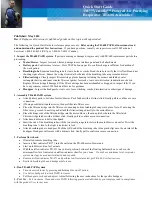
Manual 2100-689
Page
18 of 32
However, three phase compressors will rotate in either
direction depending upon phasing of the power.
Since there is a 50-50 chance of connecting power
in such a way as to cause rotation in the reverse
direction, verification of proper rotation must be made.
Verification of proper rotation direction is made by
observing that suction pressure drops and discharge
pressure rises when the compressor is energized.
Reverse rotation also results in an elevated sound level
over that with correct rotation, as well as substantially
reduced current draw compared to tabulated values.
Verification of
proper rotation
must be made at the time
the equipment is put into service. If improper rotation
is corrected at this time, there will be no negative
impact on the durability of the compressor. However,
reverse operation for over 1 hour may have a negative
impact on the bearing due to oil pump out.
NOTE:
If compressor is allowed to run in reverse
rotation for an extended period of time, the
compressor’s internal protector will trip.
All three phase compressors are wired identically
internally. As a result, once the correct phasing is
determined for a specific system or installation,
connecting properly phased power leads to the same
Fusite terminal should maintain proper rotation
direction.
The direction of rotation of the compressor may be
changed by reversing any two line connections to the
unit.
Phase Monitor
All units with three phase scroll compressors are
equipped with a three phase line monitor to prevent
compressor damage due to phase reversal.
The phase monitor in this unit is equipped with two
LEDs. If the Y signal (call for cooling) is present at the
phase monitor and phases are correct, the green LED
will light.
If phases are reversed, the red fault LED will be lit and
compressor operation is inhibited.
If a fault condition occurs, reverse two of the supply
leads to the unit.
Do not reverse any of the unit factory
wires as damage may occur.
Condenser Fan Operation
NOTE:
Certain models may be equipped with a low
ambient control (LAC), and if so, the condenser fan
motor will have a delayed start until system refrigerant
operating pressure builds up. After starting, the fan
motor may or may not cycle depending upon ambient
conditions. This is normal operation.
50 Hz models must have fan wired on low speed.
These models are factory wired on low speed.
Service Hints
1. Caution owner/operator to maintain clean air filters
at all times and also not to needlessly close off
supply and return air registers. This reduces airflow
through the system, which shortens equipment
service life as well as increasing operating costs.
2. Check all power fuses or circuit breakers to be sure
they are the correct rating.
3. Periodic cleaning of the outdoor coil to permit full
and unrestricted airflow circulation is essential
.
Sequence of Operation
COOLING – Circuit R-Y1 makes at thermostat pulling
in compressor contactor, starting the compressor
and outdoor motor. (See
NOTE
under
CONDENSER
FAN OPERATION
concerning models equipped with
low ambient control.) The G (indoor motor) circuit is
automatically completed by the thermostat on any call
for cooling operation or can be energized by manual
fan switch on subbase for constant air circulation. On a
call for heating, circuit R-W1 makes at the thermostat
pulling in heat contactor for the strip heat and blower
operation. On a call for second stage heat, R-W2 makes
bringing on second heat contactor, if so equipped.
Balanced Climate
TM
Mode
All units are equipped with the capability of running
in Balanced Climate mode. This is a mode to enhance
the comfort level by slowing the indoor blower speed to
help extract more humidity during cooling operation.
In order to activate this mode, the jumper bar between
terminals Y1 and Y2 on the low voltage terminal block
must be removed. The indoor blower will then run at
a lower speed in cooling mode. This low speed can be
overridden by utilizing a 2-stage thermostat. If the call
for cooling is not satisfied within a given time frame
(specified by the thermostat), the thermostat will send
a signal to Y2 which then increases the blower speed
back to the selected speed. See pages 27 and 28 for
blower speed selection options.
Vent Connection Plug
All units are equipped with a vent connection plug in
the side of the control panel for the different ventilation
packages to plug in to. If the compressor will not start
and there is no "Y1" at the compressor control module,
first check to make sure that either the optional vent is
plugged into the vent connection plug or the supplied
jumper plug is in place.
The unit will not operate
without anything plugged in.
This plug is located on
the side of the control panel behind the front vent door
(behind the filter access door). If the unit is supplied
with a factory-installed vent package, it will be plugged
in but the jumper plug will also be tethered next to the
connection for troubleshooting purposes, if necessary.
Содержание WA Series
Страница 2: ......
Страница 12: ......
Страница 18: ...Manual 2100 479 Page 6 of 11 FIGURE 1 TYPICAL AIR CONDITIONING SYSTEM COOLING CYCLE MIS 369...
Страница 19: ...Manual 2100 479 Page 7 of 11 FIGURE 2 TYPICAL HEAT PUMP SYSTEM COOLING CYCLE MIS 368...
Страница 24: ......
Страница 60: ...Manual 2110 1449A Page 4 of 12 FUNCTIONAL COMPONENTS 10 11 2 3 1 4 5 6 9 8 7 12 13 14 15 SEXP 949...
Страница 64: ...Manual 2110 1449A Page 8 of 12 CONTROL PANEL 14 13 6 15 18 16 4 11 7 10 9 1 3 12 17 5 2 SEXP 908...
Страница 66: ...Manual 2110 1449A Page 10 of 12 CONTROL PANEL 7 17 11 12 16 3 10 8 13 15 14 9 4 5 6 18 1 2 SEXP 948...
















































